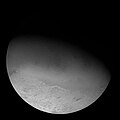 Kraken Catena and nearby
Set Catena, highlighted with arrows. The two pit chains are aligned radially from nearby
Leviathan Patera | |
| Feature type | Crater chain, tectonic rift |
|---|---|
| Location | Monad Regio, Triton |
| Coordinates | 14°00′N 35°30′E / 14.00°N 35.50°E [1] |
| Discoverer | Voyager 2 |
| Eponym | Kraken |
Kraken Catena is a pit chain (catena) and likely tectonic fault [2] on Triton, the largest natural satellite of Neptune. It, along with Set Catena, is located near and is aligned approximately radially from Leviathan Patera, a major cryovolcanic feature; as such, Kraken Catena may have played a role in rift-induced cryovolcanic activity in Leviathan Patera. [2] [3] Several of Kraken Catena's pits have central steep-sided knobs, giving a moated appearance similar to the moated mountains found on Pluto's moon Charon and Uranus's moon Ariel. [3]
As with all other surface features of Triton, Kraken Catena was discovered when Voyager 2 visited the Neptune system on 25 August 1989. It is named after the Kraken of Norse mythology; the name was officially approved by the International Astronomical Union (IAU) in 1991. It is located at 14°N, 35.5°E, within Cipango Planum and Monad Regio. [1]
- ^ a b "Kraken Catena". Gazetteer of Planetary Nomenclature. USGS Astrogeology Research Program. (Center Latitude: 14.00°, Center Longitude: 35.50°; Planetographic, +Eastt)
- ^ a b Stern, A. S.; McKinnon, W. B. (March 1999). Triton's Surface Age and Impactor Population Revisited (Evidence for an Internal Ocean) (PDF). 30th Annual Lunar and Planetary Science Conference. Houston, TX. Bibcode: 1999LPI....30.1766S. 1766. Archived (PDF) from the original on 2 April 2024. Retrieved 2 April 2024.
- ^ a b Schenk, Paul; Beddingfield, Chloe; Bertrand, Tanguy; et al. (September 2021). "Triton: Topography and Geology of a Probable Ocean World with Comparison to Pluto and Charon". Remote Sensing. 13 (17): 3476. Bibcode: 2021RemS...13.3476S. doi: 10.3390/rs13173476.
 Kraken Catena and nearby
Set Catena, highlighted with arrows. The two pit chains are aligned radially from nearby
Leviathan Patera | |
| Feature type | Crater chain, tectonic rift |
|---|---|
| Location | Monad Regio, Triton |
| Coordinates | 14°00′N 35°30′E / 14.00°N 35.50°E [1] |
| Discoverer | Voyager 2 |
| Eponym | Kraken |
Kraken Catena is a pit chain (catena) and likely tectonic fault [2] on Triton, the largest natural satellite of Neptune. It, along with Set Catena, is located near and is aligned approximately radially from Leviathan Patera, a major cryovolcanic feature; as such, Kraken Catena may have played a role in rift-induced cryovolcanic activity in Leviathan Patera. [2] [3] Several of Kraken Catena's pits have central steep-sided knobs, giving a moated appearance similar to the moated mountains found on Pluto's moon Charon and Uranus's moon Ariel. [3]
As with all other surface features of Triton, Kraken Catena was discovered when Voyager 2 visited the Neptune system on 25 August 1989. It is named after the Kraken of Norse mythology; the name was officially approved by the International Astronomical Union (IAU) in 1991. It is located at 14°N, 35.5°E, within Cipango Planum and Monad Regio. [1]
- ^ a b "Kraken Catena". Gazetteer of Planetary Nomenclature. USGS Astrogeology Research Program. (Center Latitude: 14.00°, Center Longitude: 35.50°; Planetographic, +Eastt)
- ^ a b Stern, A. S.; McKinnon, W. B. (March 1999). Triton's Surface Age and Impactor Population Revisited (Evidence for an Internal Ocean) (PDF). 30th Annual Lunar and Planetary Science Conference. Houston, TX. Bibcode: 1999LPI....30.1766S. 1766. Archived (PDF) from the original on 2 April 2024. Retrieved 2 April 2024.
- ^ a b Schenk, Paul; Beddingfield, Chloe; Bertrand, Tanguy; et al. (September 2021). "Triton: Topography and Geology of a Probable Ocean World with Comparison to Pluto and Charon". Remote Sensing. 13 (17): 3476. Bibcode: 2021RemS...13.3476S. doi: 10.3390/rs13173476.
